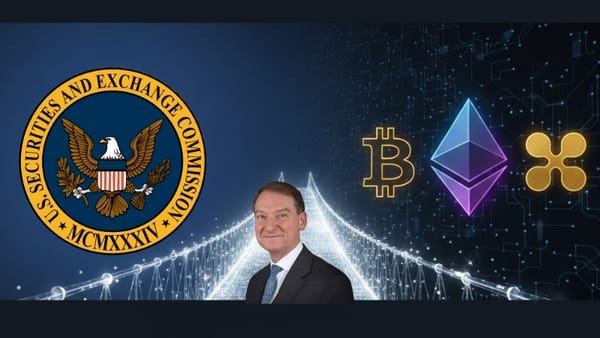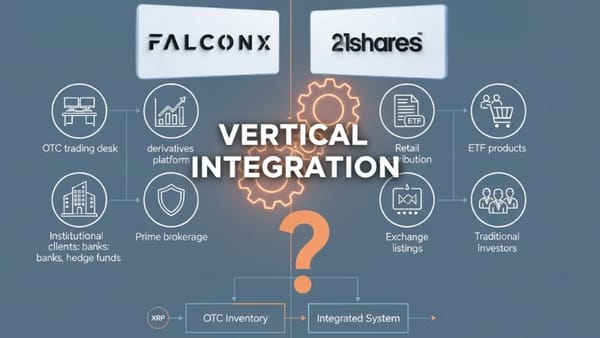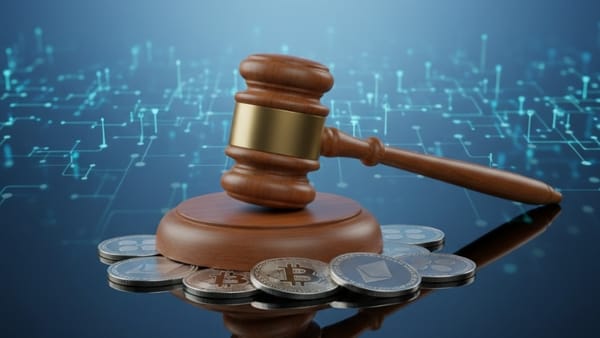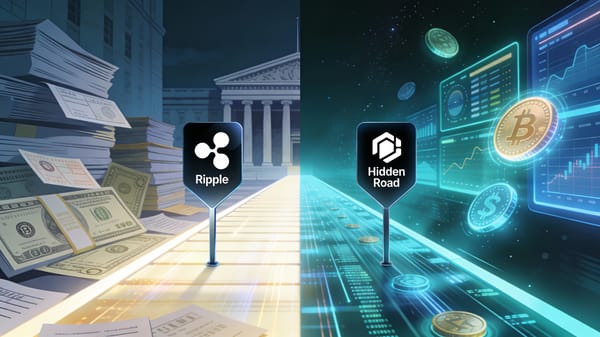Ripple's Strategic Positioning: From Federal Reserve Task Force to White House Digital Assets Council
Ripple secures Federal Reserve Faster Payments seat as White House Digital Assets Council joins Ripple Swell 2025. Strategic convergence of regulatory engagement, ISO 20022 compliance, and SWIFT integration positions XRP as bridge currency infrastructure.
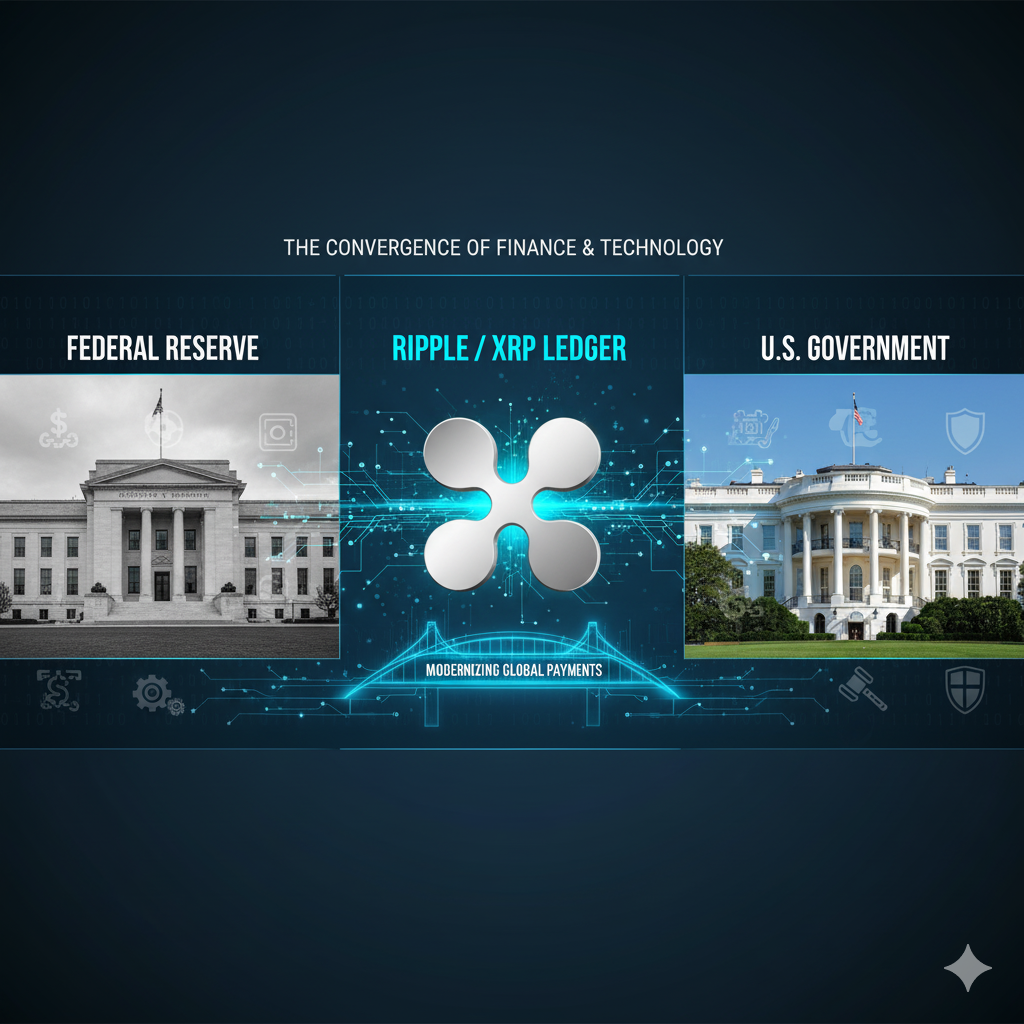
Ripple has secured a strategic position on the Federal Reserve's Faster Payments Task Force Steering Committee, marking a significant validation of blockchain technology in traditional finance. In a parallel development, Ripple announced that Patrick Witt, Executive Director of the White House's Digital Assets Council, will join as a keynote speaker at Ripple Swell 2025. These developments underscore Ripple's comprehensive strategy to integrate XRPL and XRP into the core infrastructure of global payments.
Ripple's Strategic Federal Reserve Position
Ripple, the blockchain payments giant behind the XRP token, has secured a seat on the Federal Reserve's Faster Payments Task Force Steering Committee, positioning the company at the heart of discussions about faster, more efficient financial transactions in a space historically dominated by traditional banking institutions. According to crypto researcher SMQKE, Ripple stands as the only distributed ledger technology company on the Federal Reserve's Faster Payments Task Force.
The Federal Reserve's Faster Payments Task Force was established to explore ways to accelerate U.S. payments, bringing together banks, fintech firms, and payment innovators. The Task Force brought together a diverse group of 320 stakeholders – including banks, regulators, end users and technology companies – to create a roadmap for modernizing the U.S. payments infrastructure.
Ripple's role extends beyond mere participation. McKinsey's assessment gave high marks to Ripple, noting that Ripple enables financial institutions the ability to operate cross-border payments faster than the 2-4 days common today, bolsters the certainty of the cross-border payment experience by providing end-to-end transaction visibility to banks, and enables more transparency in the total cost of a payment to the payee prior to authorization.
White House Digital Assets Council Connection
In a significant parallel development, Ripple announced that Patrick Witt, Executive Director of the President's Council of Advisors for Digital Assets at the White House, will serve as a keynote speaker at Ripple Swell 2025 in New York City, November 4-5. The announcement emphasized "this is a conversation you can't miss," highlighting the growing intersection between federal policy and blockchain infrastructure.
The timing of this announcement, coming alongside Ripple's Federal Reserve Task Force participation, underscores the company's deepening engagement with U.S. government institutions. Having a White House Digital Assets Council executive keynote at Ripple's flagship annual conference signals the level of dialogue occurring between federal policymakers and Ripple's leadership regarding the future of digital payments and blockchain integration into traditional financial systems.
This government engagement represents a dramatic shift from Ripple's previous regulatory challenges. The company's ability to attract high-level federal officials to its events while simultaneously participating in Federal Reserve payment modernization initiatives demonstrates a strategic repositioning from regulatory defendant to infrastructure partner.
XRP's Market Position and Institutional Momentum
While Ripple advances its institutional strategy, XRP's role as a bridge currency in cross-border payments continues to gain traction. Beyond market movements, Ripple's secured position on the Federal Reserve's Faster Payments Task Force Steering Committee enhances its influence in shaping future U.S. payment infrastructure, underscoring Ripple's growing recognition as a key player bridging traditional finance and blockchain-based settlement systems.
The resolution of Ripple's SEC case in 2025, with regulatory clarity establishing that XRP is not considered a security for public exchange sales, has rekindled institutional interest. This clarity, combined with Ripple's active participation in federal payment modernization initiatives, positions XRP as a compliant digital asset within the evolving regulatory framework.
XRP's utility in international payments is expanding through RippleNet, which now operates in 90+ countries and has processed over $70 billion in global volume, with XRP used as a bridge currency for many transactions. The company's On-Demand Liquidity product leverages XRP to facilitate real-time, low-cost cross-border payments, enabling financial institutions to move money globally without needing to pre-fund accounts in various foreign currencies.
Market watchers are also noting the pending SEC decisions on eight XRP ETF applications from major asset managers such as Grayscale, WisdomTree, and Franklin Templeton. While outcomes remain uncertain, the mere submission of these applications from established financial institutions reflects growing institutional appetite for regulated XRP investment vehicles.
How This Plays Into Ripple's XRPL and XRP Strategy
Ripple's Federal Reserve involvement is far from isolated — it represents a carefully orchestrated strategy to position XRP as the bridge currency for the next generation of global payments. The company's approach integrates multiple strategic layers that work synergistically to drive XRP adoption.
ISO 20022 Compliance: The Universal Language of Finance
At the foundation of Ripple's strategy lies ISO 20022 compliance, which serves as the technical backbone for integration with traditional financial systems. XRP is integrated into RippleNet, which was built to communicate using ISO 20022-compliant messaging, replacing legacy formats with structured data and improving transparency while reducing transaction errors.
These integrations are underpinned by ISO 20022 compliance, which simplifies connections to both the FedNow system and SWIFT, reducing friction for institutions seeking hybrid solutions while supporting faster, cheaper cross-border settlements and strengthening institutional trust in blockchain-based systems.
The timing is critical: SWIFT's global transition for cross-border payments is expected to be complete by November 2025. Ripple's early adoption positions it to capture market share as financial institutions upgrade their systems.
SWIFT Integration Through Multiple Entry Points
Rather than competing with SWIFT, Ripple has adopted a complementary approach. XRP is already penetrating SWIFT's network through multiple entry points, with seven prominent fintech firms—ACI, EastNets, Finastra, TAS, Temenos, Volange, and CGI—serving as active bridges between XRP and SWIFT, supporting ISO 20022-compliant cross-border payment systems.
By bridging the Interledger Protocol and SWIFT, XRP banking adoption could enable users globally to bypass legacy restrictions such as high fees or long settlement delays, serving not just large institutions but also retail and SME payments. This strategy transforms the narrative from "Ripple vs. SWIFT" to "Ripple with SWIFT."
Analysts speculate that Ripple could eventually handle a portion of SWIFT's $150 trillion annual transaction volume, potentially processing $20–30 trillion if full-scale integration is achieved.
Institutional Infrastructure Build-Out
Ripple's 2025 strategy focuses on transforming XRPL into an institutional-grade platform. Key upgrades include identity verification, a compliant trading platform, lending tools, Ethereum-based app support through EVM sidechains expected by Q2 2025, and improved ways to handle digital assets and liquidity.
The company is building comprehensive financial infrastructure: Partnerships with global banks like HSBC and Guggenheim Treasury Services demonstrate XRPL's utility in tokenizing commercial paper and cross-border settlements, while the launch of five new stablecoins including USDC, XSGD, EURØP, RLUSD, and USDB alongside tokenization of U.S. Treasuries in collaboration with Ondo Finance highlights XRPL's role as a platform for real-world asset digitization.
Banking License and Regulatory Integration
Ripple's pursuit of traditional banking status represents perhaps its most ambitious strategic move. The recent $1 billion acquisition of GTreasury, a Chicago-based fintech firm specializing in treasury management software, combined with blockchain-based settlement rails, aims to tap into the multi-trillion-dollar corporate treasury market, offering real-time cross-border settlement and repo access through XRPL.
Ripple applied to the Office of the Comptroller of the Currency for national trust bank charters in July 2025, which will allow Ripple to operate federally chartered banks, gain legitimacy, operate across state lines, and hold stablecoin reserves with direct access to the Federal Reserve system.
Global Partnership Network Expansion
Ripple's partnership strategy demonstrates geographic and sectoral diversity. Major 2025 Ripple bank partners include BNY Mellon as a primary custodian for the Ripple USD stablecoin and the Canadian Imperial Bank of Commerce, expanding their long-standing alliance, while the company partnered with more than 100 financial institutions globally using RippleNet technology and the XRP Ledger.
Regional expansion continues aggressively: In the Middle East, Ripple obtained a payments license in Dubai in March 2025 and signed UAE's Zand Bank and fintech Mamo as new customers, while in Latin America, Ripple partnered with Brazil's largest crypto exchange, Mercado Bitcoin, to enable cross-border payments in Brazilian reais.
A partnership with a leading South African bank marks a significant step into Africa's fast-developing fintech landscape, allowing the bank to integrate Ripple's custody and settlement solutions to help clients manage tokenized assets securely while staying compliant with local regulations.
The RLUSD Stablecoin Strategy
The launch of Ripple USD (RLUSD) serves as a critical bridge between traditional finance and the XRP ecosystem. RLUSD has rapidly gained traction, crossing $700 million in circulation by September 2025, with a strategic partnership with Securitize allowing holders of tokenized funds like BlackRock's BUIDL and VanEck's VBILL to swap shares for RLUSD, automating liquidity and settlement for tokenized assets in real-time.
Institutional lending capabilities include direct on-chain lending with undercollateralized loan options expected by Q3 2025, integrating Ripple's RLUSD stablecoin and real-world assets to support a more mature and stable DeFi ecosystem.
Supply Dynamics and Treasury Strategy
Ripple is also managing XRP supply strategically to support long-term value appreciation. According to SEC documents, Ripple will hand over 126,791,458 XRP to be locked and traded for company shares with ventures like Evernorth, strengthening relationships with key ventures while reducing XRP's circulating supply, an effect that could influence its long-term value.
Community members view this as significant: X user "Randon Man" noted that once all the ETFs, reserves for transfers, and companies using XRP as treasury assets take their share and those tokens are out of circulation, there will be little left for speculation, and when everything starts flowing through XRPL and RippleNet, it will be wonderful.
The Convergence Strategy
Ripple's Federal Reserve position is not an isolated achievement but rather a key component of a comprehensive strategy to embed XRP into the global financial infrastructure. The company is simultaneously:
- Gaining regulatory credibility through Federal Reserve involvement and banking license applications
- Achieving technical compatibility through ISO 20022 compliance and SWIFT integration
- Building institutional infrastructure via XRPL upgrades and real-world asset tokenization
- Expanding partnerships across traditional banks, fintechs, and central banks
- Managing supply dynamics through strategic XRP locking and treasury strategies
Ripple's deep involvement with ISO 20022, a messaging standard becoming mandatory for financial institutions by 2025, solidifies its standing in global payment discussions, with the company aiming to capture a significant portion of the cross-border payment market, potentially handling as much as 14% of SWIFT's $150 trillion transaction volume within the next five years.
Market Implications and Strategic Positioning
The convergence of regulatory clarity, technical readiness, and institutional adoption creates a potentially transformative moment for XRP as infrastructure for the modernized global financial system. Ripple's secured position on the Federal Reserve's Faster Payments Task Force Steering Committee, combined with its engagement with the White House Digital Assets Council, demonstrates the company's evolution from crypto startup to essential financial infrastructure provider.
The strategic implications extend across multiple dimensions. Ripple's Federal Reserve involvement provides direct input into how the U.S. payment system modernizes, potentially ensuring XRPL-compatible standards. The White House connection through Ripple Swell 2025 signals federal recognition of blockchain's role in future payment systems. Meanwhile, Ripple's pursuit of a national banking charter and Federal Reserve master account would complete its transformation into a hybrid institution operating in both traditional and digital finance.
For the broader cryptocurrency ecosystem, Ripple's institutional acceptance represents a validation of blockchain technology's utility beyond speculative investment. The company's ability to simultaneously participate in Federal Reserve initiatives, attract White House officials to its conferences, secure banking partnerships, and maintain ISO 20022 compliance demonstrates a viable pathway for crypto integration into regulated financial systems.
Industry observers note that Ripple's strategy differs fundamentally from purely decentralized cryptocurrency projects. Rather than positioning itself as an alternative to traditional finance, Ripple has methodically embedded itself within existing systems as an efficiency upgrade. This approach—combining blockchain innovation with regulatory compliance and institutional partnerships—may serve as a template for other digital asset projects seeking mainstream adoption.
The institutional infrastructure buildout continues at pace. With partnerships spanning more than 100 financial institutions globally, ranging from major banks like Santander, HSBC, and Bank of America to regional payment providers across Asia, Latin America, Africa, and the Middle East, Ripple has created a network effect that becomes increasingly difficult for competitors to replicate.
Conclusion
Ripple's appointment to the Federal Reserve's Faster Payments Task Force Steering Committee, combined with the White House Digital Assets Council's participation in Ripple Swell 2025, represents more than symbolic recognition — it demonstrates the company's successful strategy to position itself as essential infrastructure for the future of payments. By combining regulatory engagement, technical compatibility through ISO 20022, SWIFT integration, institutional partnerships, and continuous XRPL innovation, Ripple is building the rails for XRP to function as a bridge currency in the modernized global financial system.
The trajectory from SEC defendant to Federal Reserve participant and White House dialogue partner illustrates how Ripple has navigated perhaps the most challenging regulatory environment in cryptocurrency history to emerge as a central player in payment system modernization. This evolution required simultaneous progress on multiple fronts: resolving legal challenges, maintaining technological development, expanding institutional partnerships, and engaging proactively with regulators and policymakers.
As XRP and Ripple Labs have navigated a tumultuous journey but emerged in 2025 with renewed momentum, the resolution of the SEC lawsuit largely in Ripple's favor marks a new era of regulatory clarity that is already rekindling institutional interest in XRP and XRPL infrastructure.
The coming months will reveal whether Ripple's comprehensive strategy—spanning Federal Reserve collaboration, White House engagement, banking license pursuit, ISO 20022 implementation, and SWIFT integration—successfully positions XRPL and XRP as core infrastructure for the next generation of global payments. What's clear is that Ripple is no longer playing at the margins of finance — it's helping to write the rules for its future, with federal institutions increasingly recognizing blockchain's potential role in payment system evolution.
DISCLAIMER
This newsletter is for informational purposes only and does not constitute investment advice, advertising, or a recommendation to buy, sell, or hold any securities. This content is not sponsored by or affiliated with any of the mentioned entities. Investments in cryptocurrencies or other financial assets carry significant risks, including the potential for total loss, extreme volatility, and regulatory uncertainty. Past performance is not indicative of future results. Always consult a qualified financial professional and conduct thorough research before making any investment decisions.
Sources
- Ripple Official Blog - Federal Reserve Task Force
- Coinpaper - Ripple Joins Fed Task Force
- CoinDCX - XRP Price Prediction
- VentureBurn - XRP Price Prediction 2025-2030
- CoinDCX - Ripple Banking License Strategy
- 21Shares Research - Ripple's 2025 Plans
- Coinpedia - Ripple Partnerships After XRP Victory
- CoinDCX - Ripple SWIFT Integration
- CCN - ISO 20022 and XRP Compliance
- Bitcoinist - XRP SWIFT Integration Analysis
- AInvest - Ripple ISO 20022 Integration
- The Crypto Basic - Ripple XRP Supply Dynamics
- Coinpedia - Bitcoin, Ethereum and XRP October Predictions
- TS2 Space - XRP and Ripple 2025 Report
- Financial Markets - XRP Revolution in Global Payments
